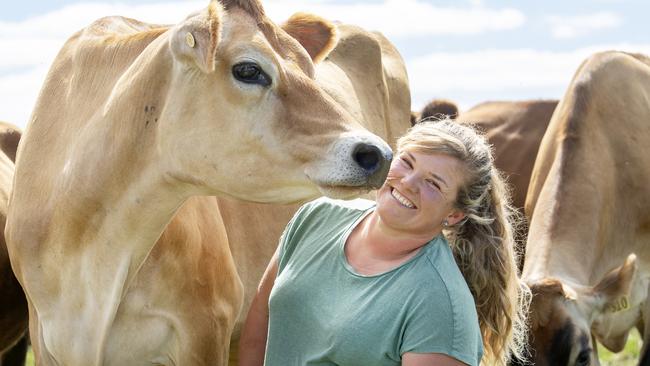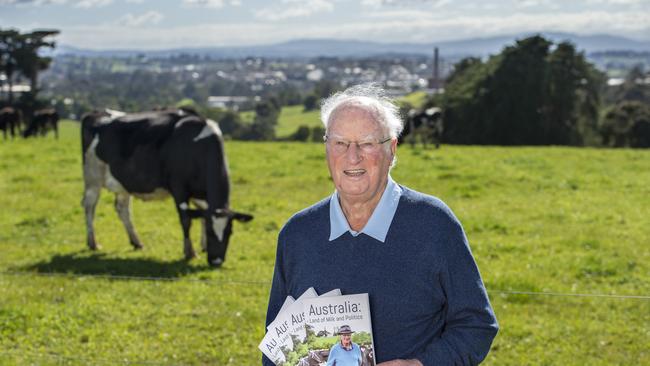Australian dairy: What is the average herd size in 2025?
We take a look at the average dairy herd size for each state and find out the issues impacting on why – including staffing issues.
Australia’s average dairy farm herd is inching close to 350 cows, with the trend away from solo owner-operators placing greater demand nationwide for employee milkers.
The most recent figure from Dairy Australia stood at an average 342 cattle in the 2023-24 financial year – a 24 per cent increase on the national average herd figure of 276 cattle in 2019.

In southwest Victoria, Warrion dairy farmer Sarah Chant has 270 Jersey cows, one full-time worker and one part-time milker.
“Without knowing the facts, I would guess around 350-400 milking cows for the average herd size (for southwest Victoria),” she said.
Ms Chant believed the average owner-operator in the region would milk about 200 cows, and a decent replacement cow would sit at around $2400.
“Prices have been down the past couple of years, I don’t know personally if they’re going to improve but the past couple of years there’s been a significant decrease in the export of heifers,” she said.
“There’s a lot of people retiring and moving into beef, and not as many younger people coming in to take their place. It’s so hard to get quality staff, those bigger places tend to have backpackers on, and finding quality staff affects people.”
Tasmania boasts the highest average herd size, clocking in at 500, according to Dairy Australia statistics. Western Australia is the silver medallist with an average herd of 440, followed by South Australia with 300 head, NSW at 280 and Queensland with the smallest average herd at about 200 cattle.
Victoria does not have a current statewide average but the most recent DA figures suggest the median figure would now be above 280.
Tasmanian farmer Mark Lambert, from Sunnyside, has 570 Jersey milking cows, 100 beef cattle and 80 ewes.
“There’s not many farmers without staff, I know one farmer and he’s milking 230 at peak numbers.”
Mr Lambert said corporate farms were a major part of Tasmania’s dairy industry, which affected the average herd size.
“Unless they can get 800 cows in a farm they’re not particularly interested and that’s part of why Tasmania’s numbers are so high,” he said.
“Fifty per cent of Tasmania’s milk is from corporate farms now.”
WA Farmers dairy president Ian Noakes said the average dairy herd west of the Nullarbor was now north of 400, following decades of farm amalgamations.
“When I was a young farmer, the average herd was in the 100s but technology and farm amalgamations changed all that. Now, we’re talking an average herd of 400 to 450 (cattle),” Mr Noakes said.
“There’s not too many corporate farms in WA, the majority are family operated with staff.
“But there are fewer and fewer farms out there that are solo operations that have to get in a relief milker for the occasional weekend off or holiday. That used to be commonplace but is disappearing fast and herd sizes are increasing as a result.”

Former United Dairyfarmers of Victoria president Bill Pyle said while the average herd size was often formed by geography and staffing capacity, around the mid 300s was now the standard in Victoria.
Official statistics confirm the average herd size nationwide in 1985 was just 93 cattle and passed the 300 mark by 2017.
“Australia and Victoria in particular should be proud that we have lay claim to the most efficient dairy farms in the world,” the retired Gippsland farmer said.
“We’ve made huge efficiency gains as an industry when you consider in west Gippsland in the 1950s, the average dairy was milking 35 to 40 head.
“Think of the overall national picture: Australia in 1970 had 60,000 dairy farmers milking 3 million cows to produce 7 billion litres of milk. Today, we have fewer than 4000 dairy farmers across Australia and we’re producing more than 8 billion litres of milk.
“I realise those production numbers are down from the peak of 11 billion litres in 2002, but we’re talking about extraordinary efficiency gains that are still not seen in many European countries that remain heavily subsidised.”




